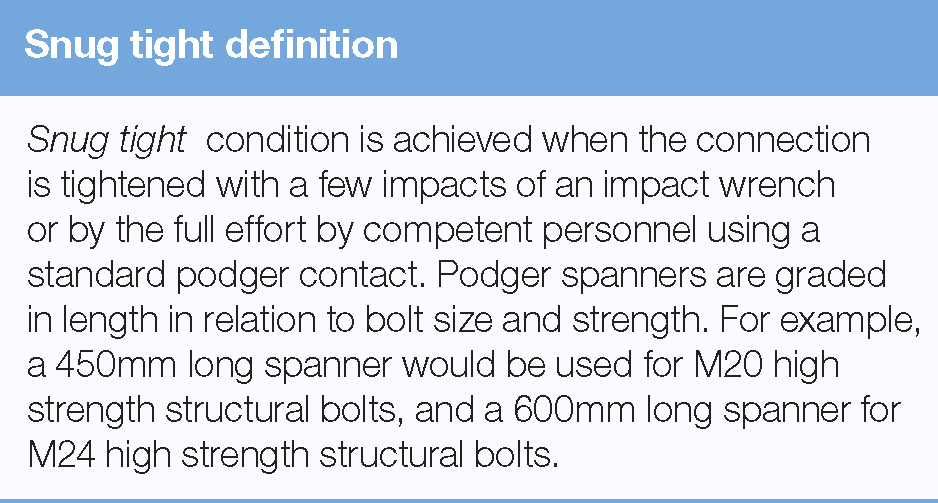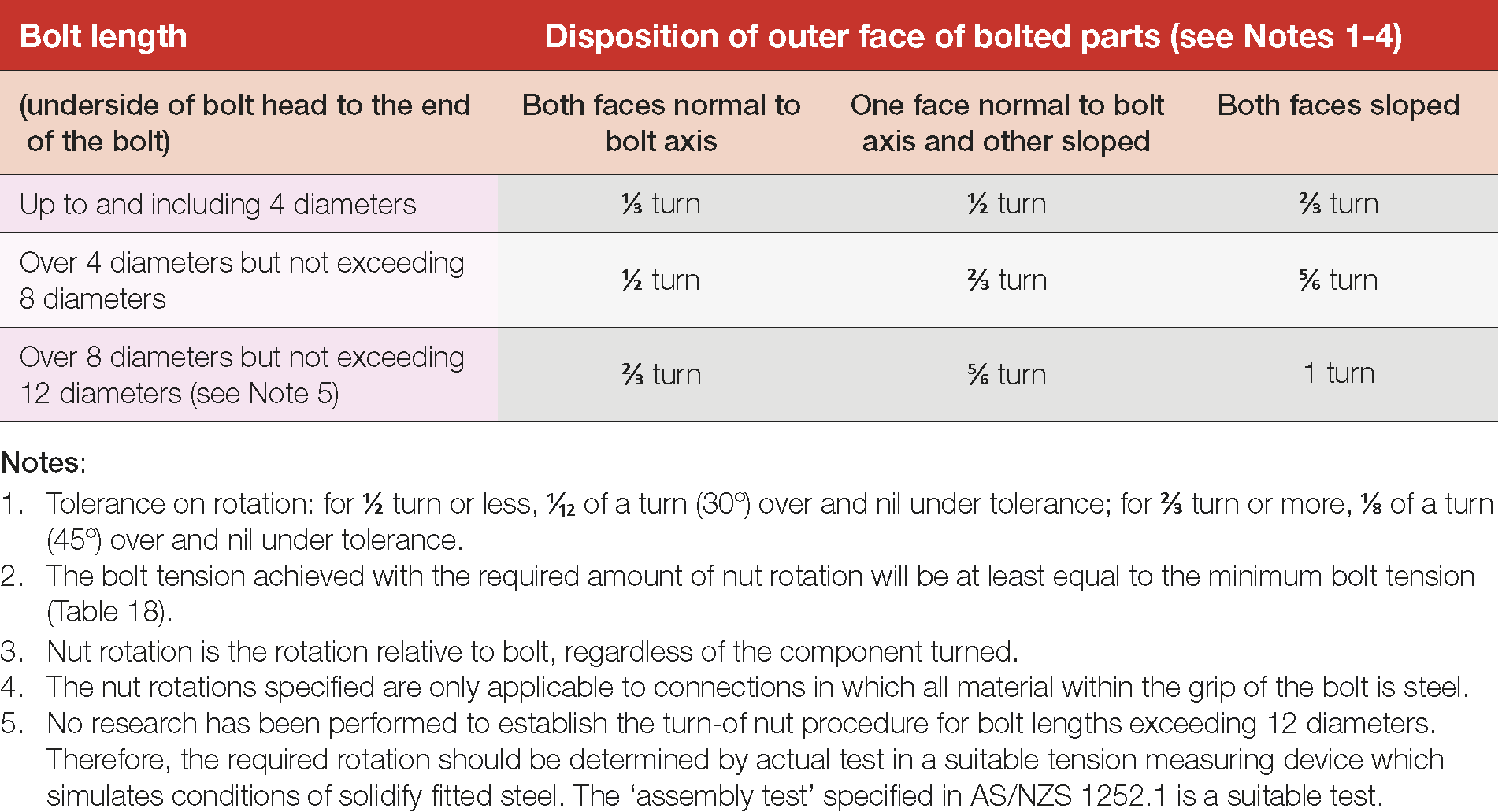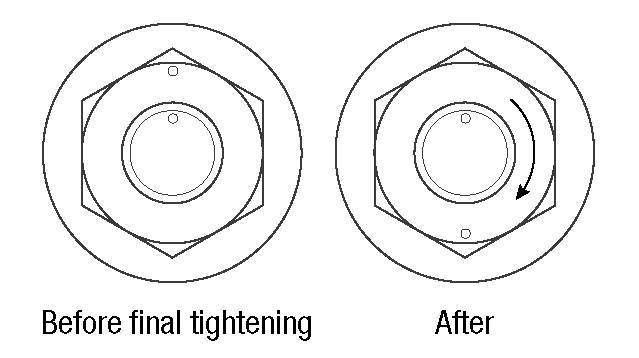Tightening procedures for high strength structural bolts
The installation and tightening of a high strength structural fastener set is at least as costly as the fastener set itself, and the selection of bolt type and bolt tightening procedure is an important consideration in the economics of high strength bolted structures.
AS/NZS 5131 specifies that all material within the grip of the fastener must be steel and compressible material is not included, except for load indicating washers. The length of a bolt must be such that at least one clear thread shows above the nut and at least one thread plus the thread run out is clear beneath the nut after snug tightening.
Nuts
Nuts must be installed so that identification marking is visible for inspection after installation. For fasteners where the assembly is subject to impact or significant vibration the construction specification should specify the method required to secure the nuts (in addition to normal tightening procedures). Clause 5.5.8 of AS/ NZS 5131 provides more information on locking devices. Assemblies subject to tension only do not require any additional locking devices.
Washers
For hot dip galvanized surfaces, a washer must be provided under the part of the fastener set (nut or bolt head) that is rotated during the tightening process. The construction specification may specify for a washer to be placed under both the nut and the bolt head where it is deemed necessary.
Where oversized or slotted holes are used, plate washers are required (see Hole Design). These plate washers must have similar mechanical properties to other components of the connection and all components must have compatible coatings with similar corrosion resistance.
Snug tightening of bolts
All bolt holes must be aligned to permit insertion of the bolts without damage to the thread. Drifting to align holes must be carried out in a manner that does not distort the steel or enlarge the holes.
Re-use of bolts used in snug tightening is permitted so long as the bolt and the thread are undamaged and the nuts run freely in accordance with Clause 8.2.3 of AS/NZS 5131.

Snug tightening is applied in the following situations:
1. Category 4.6/S: The final level of bolt tightening in general structural bolting using commercial bolts.
2. Category 8.8/S and 10.9/S: The final level of bolt tightening using high strength structural bolts. Different design values must be applied than for procedures 8.8/TF and 8.8/TB using the same bolts, as discussed in Variation in design values with bolt strength and joint design.
3. Category 8.8/TF, 8.8/TB, 10.9/TF, and 10.9/TB: An intermediate level of bolt tension applied as the first stage in full tightening.
The growing popularity of high strength structural bolts to AS/NZS 1252.1 used in a snug tight condition leads to the situation where bolts may require further tightening to AS/NZS 5131 in one application and only snug tightening in another. To prevent confusion and ensure correct tightening, the designer must show the level of tightening required in both drawings and specifications. Steps must be taken to ensure that this information is conveyed to all those involved in installation, tightening and inspection.
Tensioning of high strength bolts
For joints designed in accordance with AS 4100, either as 8.8/TF and 10.9/TF friction type joints or 8.8/TB and 10.9/TB bearing type joints, all bolts must first be tightened to the snug tight condition. All bolts in a completed connection are to be tightened to at least the minimum bolt tension (Table 18) defined as the stress under proof load (Sp) x stress area (As) as required in AS 4100 and AS/NZS 5131. This can be achieved using either the part-turn method of tensioning or using a direct-tension indication device.
High strength bolts that are to be tensioned can be used temporarily during erection to facilitate assembly of a connection. These bolts should not be fully tensioned until all the bolts in the connection have first been tightened to the snug tight condition.
Table 18: Minimum bolt tension after tightening for high strength bolts
Torque control tightening of galvanized bolts and nuts is not explicitly prohibited in the Standards; however it has not been widely used in Australia because of the variable torque and induced tension relationship of zinc coatings, even when lubricant coated (see Torque and induced tension relationship in tightening for a historical research). The ASI says that:
Using a torque wrench to tighten bolts to a defined tension is accepted practice in both Europe and America. However, this approach does require a known and reproducible relationship between torque applied to the bolt and the resulting tension, which can be significantly affected by bolt properties such as thread engagement and coating. Historically, in the Australian marketplace and in particular with regard to both our significant adoption of galvanized bolts and issues with compliant supply, there has not been the confidence with torque-controlled methods of tightening.
There is an expectation that with the revision to AS/NZS 1252, including significant focus on ensuring compliant supply, the market will respond positively, and we will get improved compliance and bolt assembly performance. This then opens the door to confidence that we will be able to procure bolt assemblies with a reliable torque-tension relationship.
Part turn tightening
Part turn tightening is to be completed after snug-tightening. Location marks are made in order to mark the position of the bolt and nut in relation to each other in order to be able to control the amount of final nut rotation. These marks can then be used for final tightening and inspection. Taper washers are required if the surface slope exceeds 3° and flat washers must be used under the rotating component.
Rotate the nut by the given amount in Table 19 and whilst completing the final tensioning the component not turned by the wrench must not rotate. Where it is impractical to turn the nut due to access or other reasons the bolt may be rotated so long as there is a washer under the bolt head and any rotation of the nut is prevented.
Table 19: Nut rotation from the snug tight position
Direct tension indicator tightening
Several direct tension indicating devices have been developed to provide a simple method of checking that minimum bolt tension has been developed. The requirements for use are
- The device must show it is suitable for the application by testing a representative sample of at least three bolts for each diameter and bolt length combination and for each grade of bolt that will be used. The bolt assemblies used for testing must be taken from the same assembly group being used for the project. The test must be carried out by a calibration device that indicates the bolt tension. The calibration test must demonstrate a tension of at least 1.05 times the minimum bolt tension given in Table 18.
- All bolts must be snug tightened prior to using the direct tension indicator.
- The bolts must then be tensioned to the minimum bolt tensions specified in Table 18. These values should be indicated by the direct tension indication device. Tensioning should only be carried out by competent personnel and adhere with the tension indication device manufacturer’s specification.
Tightening procedure with load indicator washers
The most used direct tension indicating device in Australia is the load indicator washer. The load indicator washer is similar in size to a normal circular washer, with four to seven protrusions depending on size, on one face of the washer (Figure 21). The washer is assembled under the bolt head so that the protrusions bear on the underside of the head (Figure 21). As the bolt is tightened the protrusions are flattened and reduction of the gap by a specified amount indicates that minimum bolt tension has been reached. If over compression does occur, the whole assembly including the compression washer must be removed and replaced with a new assembly and new compression washer.
In applications where it is necessary to rotate the bolt head rather than the nut, the load indicator can be fitted under the nut using a special nut face washer which is heat treated to the same hardness as the bolt. Care must be taken that the nut face washer is fitted concentric with the nut and the correct way up, otherwise it may turn relative to the load indicator resulting in inaccurate load indication due to damage to the protrusions.
Experience has shown that on medium to large projects the extra cost of load indicators is offset by major savings in installation, supervision, and inspection of high strength joints.
Assembly testing and minimum nut rotation
Assembly testing for fasteners are a requirement of AS/NZS 1252.1. The test verifies the suitability of high strength bolt, nut, and washer assemblies for tensioning in steelwork construction.












